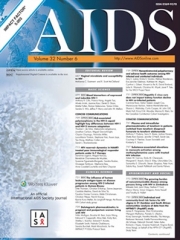Posted on May 15, 2015
Source: AIDS

Zachor, Hadas; Machekano, Rhoderick; Estrella, Michelle M.; Veldkamp, Peter J.; Zeier, Michele D.; Uthman, Olalekan A.; Taljaard, Jantjie J.; Moosa, Mohammed R.; Nachega, Jean B.
Objective: To describe the incidence of rapid kidney function decline (RKFD), and stage 3 chronic kidney disease (CKD) in HIV-1-infected adults initiated on tenofovir-containing antiretroviral therapy.
Methods: A retrospective cohort study at the infectious diseases clinic of Tygerberg Academic Hospital in Cape Town, South Africa. Patients with more than 3 ml/min per year decline in estimated glomerular filtration were classified as having RKFD, and stage 3 CKD was defined as a value less than 60 ml/min per 1.73 m2. We used logistic and Cox proportional hazards regression models to determine factors associated with RKFD and stage 3 CKD.
Results: Of 650 patients, 361 (55%) experienced RKFD and 15 (2%) developed stage 3 CKD during a median interquartile range follow-up time of 54 (46.6–98) weeks. For every 10-year increase in age and 10 ml/min lower baseline estimated glomerular filtration, the odds of RKFD increased by 70% [adjusted odds ratio = 1.70, 95% confidence interval (CI) 1.36–2.13] and 57% (adjusted odds ratio = 1.57, 95% CI 1.38–1.80), respectively. Each 10-year older age was associated with a 1.90-fold increased risk of developing stage 3 CKD (adjusted hazard ratio = 1.90, 95% CI: 1.10–3.29). Women had about four-fold greater risk of stage 3 CKD compared with men (adjusted hazard ratio = 3.96, 95% CI: 1.06–14.74).
Conclusion: About half of our study population developed RKFD but only 2% progressed to stage 3 CKD. Approaches that provide balanced allocation of limited resources toward screening and monitoring for kidney dysfunction and HIV disease management are critically needed in this setting.